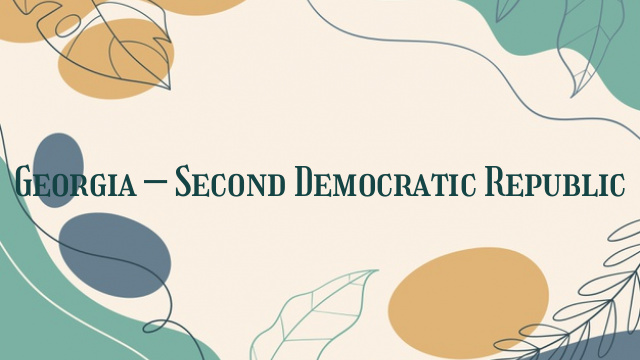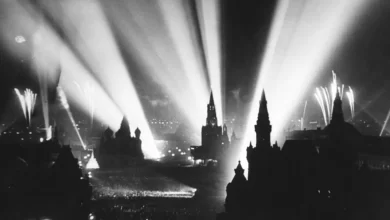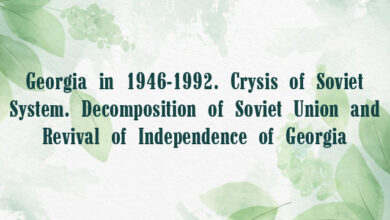
Georgia – Second Democratic Republic
The last decade of the 20th century proved to be extremely tense for Georgia. Ethnic conflicts and civil wars, combined with severe economic and political crises, had devastated the country, turning it from one of the most prosperous Soviet republic into one of the poorest and underdeveloped states in Europe. Georgia’s political development during these years of turmoil and her struggle to maintain independence vis-à-vis the neo-imperialist aspirations of Russia, are very complicated and difficult to illustrate.
The success of the Georgian national-liberation movement, which culminated in the Georgian declaration of independence in 1991, soon proved to be bittersweet. President Zviad Gamsakhurdia’s anti-Russian and nationalistic policies, and increasingly authoritarian rule led to an acute political conflict in Georgia in 1990-1991. The government adopted the doctrine of “hosts and guests” and threatened national minorities residing in Georgia. Gamsakhurdia himself saw enemies everywhere around him and denounced his political opponents as “agents and stooges of the Kremlin.” The new president’s erratic policies soon led to the resignation of several key government members, including Prime Minister Tengiz Sigua and Foreign Minister Giorgi Khoshtaria.
In the fall of 1991, demonstrations against Gamsakhurdia’s government regularly took place in Tbilisi. Georgian society, including national security forces, became split into two opposing sides. As clashes escalated in Tbilisi, Gamsakhurdia declared a state of emergency and cracked down on the opposition. Some units of the National Guard, led by Tengiz Kitovani, withdrew to the outskirts of the Georgian capital, where they defied orders to disband and began preparations for a military coup. Gamsakhurdia’s former allies joined forces with the opposition, which now included the National Independence Party (Irakli Tserteli), Popular Front (Nodar Natadze), Rustaveli Society (Akaki Bakradze), National Democratic Party (Giorgi Chanturia), etc.
In late December 1991, Kitovani’s forces launched an assault on Tbilisi and were supported by the Mkhedrioni paramilitary units led by Jaba Ioseliani. By 22 December, the rebels besieged the Parliament building, where Gamsakhurdia and his loyal troops put up a fierce resistance. The resulting fighting led to many deaths and destruction of the central district of Tbilisi. On 6 January 1992, Gamsakhurdia finally broke through the blockade and escaped to Armenia and then to Chechnya, where he organized his government in exile. Kitovani and Ioseliani, with support of former Prime Minister Tengiz Sigua, established an interim government, the Military Council. To legalize their coup against a democratically elected president, the members of the Military Council invited Eduard Shevardnadze, whose international clout was imperative to decriminalize the new authorities. In March 1992, Shevardnadze became the head of the State Council.
Meanwhile, the situation in Georgia escalated and led to ethno-territorial conflicts that plunged the country in the abyss of civil war and economic collapse. In February 1992, fighting intensified in South Ossetia, where Russia provided covert support for separatists. Shevardnadze was forced to make concessions and signed an armistice in July 1992 that established the Joint Control Commission to regulate the conflict. Fighting in Ossetia was barely over when tensions in secessionist Abkhazia, also supported by Russia, led to violence in August 1992. Georgian authorities dispatched the National Guard and paramilitary units and the sporadic clashes soon escalated into a major war between the Russian-backed separatists and Georgian forces. Within a year, Georgian troops were routed and some 300,000 Georgian and other residents of Abkhazia expelled in a widespread ethnic cleansing of the region.
The entanglement of official Tbilisi in Abkhazia encouraged Zviad Gamsakhurdia to return to Georgia, where he rallied forces in his native region of Mingrelia (Samegrelo) and in Tbilisi. In June 1992, Zviadists seized the state television center in Tbilisi, but were driven out by the National Guard. In 1993, the pro-Gamsakhurdia forces under Colonel Loti Kobalia launched a surprise attack against the government troops in Mingrelia and occupied strategic positions in the regions. Their actions played a crucial role in the failure of Georgian forces in Abkhazia since reinforcements were delayed or diverted to fight the insurgency. Threatened on both fronts, Shevardnadze was forced to make concessions to Russia and join the Commonwealth of Independent States (CIS) in return for Russian military support against the rebels. In October 1993, Georgian government forces, supported by the Russian troops, launched a counterattack against Gamsakhurdia’s forces; the Russian navy landed troops to secure the strategic port of Poti. Heavy fighting took place around Samtredia, Khobi, Senaki and Zugdidi; the combat was particularly savage in Mingrelia (Samegrelo) proper, where the Mkhedrioni paramilitary units went on a rampage. These atrocities contributed to the eventual antagonism of Mingrelians towards Shevardnadze and his government. By December 1993, most of Mingrelia was under government control and the pro-Gamsakhurdia leaders imprisoned; Gamsakhurdia himself was found dead under suspicious circumstances (the official version supports a suicide) near the village of Jikhashkari.
The civil war remains one of the most dramatic and decisive events in history of modern Georgia. A prosperous Soviet republic, Georgia was completely devastated during the three years of conflict, with the economy and industry shattered and the population suffering from gas and electric outages. The collapse of the central authorities led to the rise of numerous criminal gangs while the activities of Mkhedrioni paramilitary units affected thousands of citizens throughout the country. The civil war certainly contributed to the separatist movements in Ossetia and Abkhazia by radicalizing the sides involved in this conflicts and diverting much-needed Georgian resources. Other regions, notably Adjara and Javakheti, became increasingly defiant of the central authorities. Furthermore, Georgian society itself became split into two irreconcilable sides that became engaged in a vicious struggle for the next decade.
As the conflicts in Abkhazia and Ossetia subsided in 1994, Shevardnadze turned to domestic affairs and sought to restore the central authority that was gravely weakened during the turmoil. Over the next three years, he outmaneuvered his political opponents and consolidated his authority. The once powerful warlords Jaba Ioseliani and Kitovani were imprisoned and paramilitary units banned. In August 1995, a new Constitution was adopted establishing the institute of the Presidency and the Parliament. In 1995, and later in 2000, Shevardnadze was elected President of Georgia, though elections were marred by claims of widespread fraud and vote rigging. In August 1995, Shevardnadze barely survived an assassination attempt during the official signing ceremony of the Constitution on 29 August and used this event to get rid of his opposition. In early February 1998 Shevardnadze survived another attempt on his life and investigations alleged Zviadist involvement, leading to increased persecutions of Gamsakhurdia’s supporters. In October 1998, a two-day armed insurrection by pro-Gamsakhurdia troops threatened to destabilize Georgia but ended after the mutineers surrendered to government forces.
Shevardnadze’s presidency constitutes an important period in the recent history of Georgia. On his arrival, the country was ravaged by a civil war and ethnic conflicts, the economic and industrial infrastructure was largely destroyed. Georgian society itself was demoralized, divided into factions and dominated by warlords. Using his former contacts in the diplomatic world, Shevardnadze established close relations with the United States, which he perceived as a counterbalance to the Russian influence in Transcaucasia. Georgia soon became a major recipient of U.S. foreign and military aid, signed a strategic partnership with the North Atlantic Treaty Organization (NATO) and even declared its goal of joining NATO and the European Union (EU). One of Shevardnadze’s major achievements was showing to Western and American policymakers that Georgia can serve as a secure East-West energy corridor, which allowed Tbilisi to secure a multi-billion oil pipeline project (Baku-Tbilisi-Ceyhan) to transport oil from the Caspian Sea to the European markets. In 1999, Georgia celebrated another important success as it joined the Council of Europe and, in 2000, Tbilisi became the 137th member of the World Trade Organization. In 2002, Georgia announced its resolve to seek full membership in the Euro-Atlantic alliance, becoming a member of NATO’s Partnership for Peace.
However, Shevardnadze’s relative successes in foreign affairs were more than outweighed by domestic failures. While economic reforms were launched, they were not far-reaching enough and were often erratically enforced. The shadow economy accounted for as much as 60 percent of the country’s economic product as tax evasion, smuggling, extortion, bribery and rigged privatization became pervasive. Shevardnadze was unable to restore central authority in some regions, especially in Adjara. Supporters of Gamsakhurdia and other dissidents were persecuted and many imprisoned on trumped-up charges. Corruption became so rampant that Georgia became known as one of the world’s most corrupt countries. Shevardnadze’s closest advisers and associates, including members of his family, exerted disproportionate economic power and controlled large portions of the oil trade and media holdings. In 2001, Shevardnadze began an extensive anti-corruption reform but it proved to be an empty gesture. In October 2001, public discontent led to protests in Tbilisi, after Rustavi 2, an independent television station that had been critical of the government, was raided by security officials. Public demonstrations forced Shevardnadze to announce the dismissal of his entire government in November. In April 2002, economic woes were worsened by a natural disaster as a powerful earthquake rocked Tbilisi, causing extensive damage to some 2,500 buildings.
Irritated by Georgia’s pro-Western course, Russia actively encouraged separatism in Abkhazia and Ossetia while effectively declaring an economic blockade that resulted in widespread power and gas cuts in Georgia. The escalating war in Chechnya further deteriorated Russo-Georgian relations as Russia accused Shevardnadze of harboring Chechen guerrillas. After the terrorist attacks in the United States on 11 September 2001, Georgia became a strategic partner in the American war against international terrorism. Tbilisi offered Georgian airspace and airfields to America during the operations in Afghanistan and Iraq and contributed troops to the international contingent in Iraq. In 2002, Shevardnadze turned to the U.S. for assistance to enhance Georgia’s military preparedness and a special Train and Equip Program to train the Georgian army was launched with the financial backing from Washington.
The charges of dishonesty and fraud left Shevardnadze’s vulnerable during the Parliamentary elections of 2003. The officially announced results of this election favored Shevardnadze’s ruling party but were immediately denounced as rigged and unfair by the opposition and international election observers. This caused massive demonstrations, popularly known as the Rose Revolution, demanding the resignation of the president. Led by Shevardnadze’s one-time protégés, Zurab Zhvania, Nino Burdjanadze and Mikhail Saakashvili, the protesters broke into Parliament on 21 November 2003, forcing Shevardnadze to escape with his bodyguards. Pressured by foreign powers, Shevardnadze announced his resignation on 23 November and was replaced as president on an interim basis by Burdjanadze.
Thus, a powerful coalition of reformists headed by Saakashvili, Burdjanadze and Zhvania found itself at the helm of the state. In January 2004, Saakashvili won a landslide victory in the presidential elections. He pushed through constitutional amendments that strengthened the powers of the president and restored the post of prime minister for his ally Zurab Zhvania. Saakashvili’s first great success came in removing Aslan Abashidze, the defiant leader of Adjara, and bringing this region back under control of the central authorities. He sought to reconcile Georgian society by rehabilitating former President Zviad Gamsakhurdia and releasing Gamsakhurdia’s supporters who were imprisoned by the Shevardnadze government. Saakashvili also pushed through the change of state symbols and adopted new national flag and coat of arms in 2004; furthermore, in a bid to portray Georgia as a European state, the new administration had ordered the flag of European Union to be flown together with the state flag at government buildings.
Economic reforms and improvements in living standards are of great priority since almost half of the population of Georgia lives below the poverty line. The low rate of economic growth places Georgia as 100th out of the 177 countries listed in the United Nation Development Program’s Human Development Report of 2005, significantly lower than most of the transitional countries. A growing gap between the rich and poor is also of great concern. Saakashvili’s government directed its efforts to fighting the widespread black economy, reforming tax codes, imposing more rigorous tax-collection and making the country more attractive for foreign investment. Georgia’s economic reforms and new round of privatization earned praise from the international community and helped secure new credit lines from the International Monetary Fund and World Bank. The military forces were substantially modernized and increased. More far-reaching, and dramatic, was the new government’s anti-corruption campaign that purged the government bureaucracy of thousands of officials. The family and clan structure of Georgian society continued to facilitate a system in which corruption could easily flourish. Thus, the watchdog Transparency International ranked Georgia on the 124th place (out of 133) in 2003 and on the 133rd place (out of 145) in 2004. It remains to be seen if the new government will be able to eradicate corruption – which is so widespread and deeply rooted in Georgian society – in the short term.
Another priority spelled out by Saakashvili after his election is bringing back the breakaway regions under Georgian authority. After restoring control of Adjara, the new presidency shifted its attention towards the separatist region of South Ossetia, which led to sharp tensions and brief clashes between the two sides. In 2006-2007, Tbilisi supported the establishment of the pro-Georgian forces in South Ossetia, where an alternative government (led by Dmitri Sanakoyev) was formed to counter-balance the separatist authorities. In May-June 2007, the Georgian government made a major push to have international community recognize Sanakoyev’s government, a first step in the potential conflict resolution. In late June 2007, Sanakoyev made an unprecedented three-day visit to Brussels as part of Tbilisi’s campaign to align conflict resolution in Georgia with European, rather than Russian, interests.
In Abkhazia, after years of status-quo, political situation has slightly changed in the fall of 2006, when the Georgian authorities carried out a security operation against a rebel warlord in the Upper Abkhazia and, after securing the region, moved the seat of the Abkhazian government-in-exile there. This decision caused an outcry on the part of the Abkhaz separatists, as well as in Russia, who denounced Tbilisi’s actions as a first step towards forceful resolution of the conflict. Since then, the Abkhaz authorities refuse to participate in diplomatic negotiations until Tbilisi agrees to remove the Abkhazian government-in-exile from the upper Abkhazia.
The issues of Abkhazia and South Ossetia are very sensitive indeed and cannot be seen separately from the relations with Russia, which exerts great influence in the separatist regions; as former Georgian president Eduard Shevardnadze once commented, “the keys to the conflict resolution in these regions lay in the Russian hands.” Yet, Relations with Russia remain of major concern in light of Russia’s continuing political, economic and military support of separatist authorities in both regions. The new government of Georgia pursues a strongly pro-Western, particularly pro-US, foreign policy and seeks Georgian membership in the NATO and the EU. After the start of the American war in Iraq, Georgia joined the coalition forces and remains one of the major contributors to the coalition in terms of a country’s per capita troop deployment. In 2004, the North Atlantic Council of the NATO approved the Individual Partnership Action Plan of Georgia (IPAP). In May 2005, Georgia was visited by the U.S. President George W. Bush and greeted by tens of thousands of Georgians at the Freedom Square in Tbilisi. With the US backing, Georgia achieved a historic agreement with Russia on the complete withdrawal of Russian military bases by 2008. Such pro-Western overtures only embitter Georgia’s northern neighbor, which still perceives south Caucasia as its sphere of influence and vital to its geo-strategic interests.
In 2006, the Russo-Georgian relations hit a new low. In the spring, in the so-called “wine war,” Russia banned the imports of Georgian wine. The official explanation that the ban was motivated by health concerns was hardly convincing since Georgia had long been supplying the Russian market and sudden detection by the Russians of health hazards in Georgian wine naturally raised eyebrows. Furthermore, the ban was not followed by an order to remove Georgian wine already in Russia, which would have been a logical move to protect the Russian consumers from a detected health concern. Ironically, even after the ban, Georgian wine products continued to appear suggesting that a significant portion of the Georgian wine was produced/falsified inside Russia. Still, Russia’s decision to close its market had a serious effect on the Georgian winemakers, who scrambled to seek new markets for their products. Despite initial difficulties, the Russian ban may end up benefiting the Georgian wine business since it was compelled to diversify its markets and introduce Georgian wine to new regions.
The Russo-Georgian squabbles were not limited to the “wine war” alone but the intrastate relations further deteriorated in September/October 2006 when the Georgian government arrested four Russian military officers on charges of espionage; seeking arrest of one more Russian officer, the Georgian authorities surrounded the headquarters of the Russian forces in Transcaucasia located in Tbilisi. This event brought the Russo-Georgian relations to the lowest point in over a decade. In response to Tbilisi’s actions, Russia summoned its ambassador to Georgia and withdrew almost all of its embassy’s staff, and imposed a series of punitive measures on Georgia, suspending all land, see, and air transportation between Georgia and Russia, banning Georgian exports to Russia, and locating, rounding up, and deporting many legal and illegal Georgian migrants from Russia. Such persecutions led to international outcry condemning Russian authorities for their xenophobic actions.
Relations between Tbilisi and Moscow remain tense, although in June 2007, Presidents Saakashvili and Putin agreed to normalize relations and Russia pledged to lift its sanctions. Yet, another incident in early August revealed the ongoing deep conflict between Russia and Georgia. According to the findings of two international groups of experts, on 6 August, an unidentified aircraft intruded into Georgia’s airspace from Russia, fired anti-radar missile at the Georgian military radar installation and flew back to the Russian Federation. Russia vehemently denied its role in this incident and suggested the it was staged by the Georgian authorities for propaganda purposes. The incident further highlighted the gap between Russia and the US, when the official Washington sided with Tbilisi and denounced Russian actions.
Historical Dictionary of Georgia
by Alexander Mikaberidze (Author)
Series: Historical Dictionaries of Europe (Book 50)
Hardcover: 784 pages
Publisher: Scarecrow Press (March 16, 2007)
Language: English
ISBN-13: 978-0810855809
ISBN-10: 0810855801




